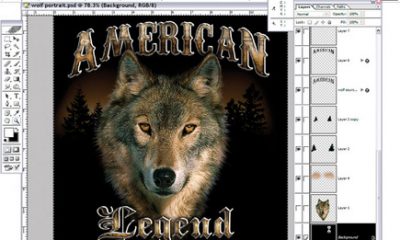Digital Printing
Published
19 years agoon
When I think about today’s competitive business climate and the changes and challenges facing the graphics industry, I am reminded of an African parable I learned during a visit to Kenya years ago: Every morning, a gazelle wakes up knowing it must run faster than the fastest lion. Every morning a lion awakens knowing it must outrun the slowest gazelle. It doesn’t matter if you are a lion or a gazelle—when the sun comes up you’d better be running.
When I think about today’s competitive business climate and the changes and challenges facing the graphics industry, I am reminded of an African parable I learned during a visit to Kenya years ago: Every morning, a gazelle wakes up knowing it must run faster than the fastest lion. Every morning a lion awakens knowing it must outrun the slowest gazelle. It doesn’t matter if you are a lion or a gazelle—when the sun comes up you’d better be running.
I bet that many graphics producers in our industry feel they are running frantically just to keep pace with the changes in technology, new printer models and manufacturers, and new media types, applications, and inks, as well as the unique and evolving business environment in which we operate. In this dynamic global marketplace, that’s an awful lot of information to chase.
In this installment, I will focus on the rapidly transforming wide-format (24- to 99-in.) digital graphics market in the US. Just what exactly is going on here? As Yogi Berra once said, "You can learn a lot just by watching." Industry consultants and analysts like myself have carefully watched the wide-format digital graphics market develop for more than a decade, and if one thing is clear, it’s that the market is more complicated and competitive than ever before. In making decisions, anyone involved in graphics production must carefully weigh market information and commentary as they apply to different market segments. Today, few general observations can be accurately applied to this increasingly fragmented market.
Who’s buying, and who’s still not buying?
Web Consulting recently conducted a US research project aimed at not only users of wide-format inkjet printers, but also shops that have not yet purchased wide-format inkjets. While both sets of results were interesting, the conclusions that can be drawn from them are perhaps not what many suppliers—especially printer manufacturers—want to hear.
This research was conducted in April of 2005 and unveiled a new and troublesome trend for printer manufacturers: The number of shops looking to buy their first wide-format inkjet printer has reached its lowest point in ten years. The population of potential new users is currently very small, so printer manufacturers need to compete against one another for existing customers. Of the non-user shops we surveyed, only 8% have any plans to adopt wide-format inkjet technology and buy a printer in the next year. So if you don’t have one of these printers and don’t feel you need one, you are not alone.
There were several specific reasons mentioned for this, including the financial benefit of outsourcing, the dramatic learning curve (or perhaps the learning "cliff") required for using this new technology, the complexity of what supplies work with which printers, the fact that inkjet is simply outside these remaining shops’ core businesses, and the belief that there are already enough shops with inkjets to satisfy market demand. I would have a difficult time arguing against some of these reasons.
To add insult to injury, the purchasing trend for new printers within the established wide-format inkjet user base also is falling. For example, in 2003 an average 44% of the shops surveyed were planning a new wide-format inkjet purchase in the next 12 months. In 2004, this number dropped to 29%. And in our most recent survey for 2005, only 12% of shops surveyed are planning a new wide-format inkjet purchase. This trend is unfortunately one that applies to all US market segments—screen printers, photo labs, and sign shops alike.
From a unit sales perspective, it is fair to say that the market has clearly passed its peak. The waves of new printer models and even new manufacturers that flooded the market in 1998 and again in 2000 have long passed. The tide now appears to be running out, and many manufacturers have had to result to price cutting to keep up sales volumes. This has especially impacted the suppliers of aqueous inkjet printers.
Despite these decreases, thousands of printers still are sold here in the US, and I’m definitely not forecasting an utter market collapse here. But what exactly are shops buying and printing? Well, it depends on the shop. It’s fair to say that the overall market picture today is much different than in past years.
From our recent research study, our snapshot of the current US printer installed base reflects a declining market share for aqueous inkjet printers (Table 1). There is no question that aqueous inkjet technology is losing share to the solvent and eco-solvent inkjet printers in an already shrinking market. In 2003, aqueous inkjet printers represented 89% of the overall US installed base of wide-format inkjet printers, while the solvent and eco-solvent segment captured 7% and UV inkjets got 4%. In 2005, however, the share of solvent/eco-solvent category of wide-format inkjets has nearly tripled to 19% of the total installed base, UV inkjets have grown to 6%, and aqueous has dropped to 75%.
Table 1 Share of US installed base by wide-format inkjet technology
Inkjet Technology Market Share
2003 2004 2005
Aqueous 89% 81% 75%
Oil-based NA 2% 0%
Solvent/eco-solvent 7% 12% 19%
UV (roll fed or flatbed) 4% 5% 6%
This trend is expected to continue. Fewer and fewer shops plan to purchase an aqueous inkjet printer, while more and more plan to purchase eco-solvent or solvent printers. That said, I do believe that both technologies will continue to satisfy the needs of various segments of the market. But those traditionally big chunks of the market will be much smaller pieces in the future.
How much change can we handle?
Another quote that has a lot of bearing on the current state of the wide-format digital graphics market comes from Charles Darwin: "It is not the strongest of the species that survives, not the most intelligent, but the one most responsive to change." So it appears that not only must we run for our business survival, but we also must maintain the flexibility to change in order to remain competitive.
For many print shops—and for many suppliers—remaining competitive has meant cutting prices. I recently spoke with an industry colleague who, before making a presentation, asked the audience how many shops made their revenue goals last year. About half of the people in the room raised a hand. That wasn’t too bad given the recent economic climate. He then asked how many made their profit goals last year and only one person raised his hand. After the presentation, that lone person felt obliged to add comment. He said the only reason his shop hit its profit goal was because he projected they would lose money. While they were still not profitable, they ended up losing less than expected.
We have confirmed this trend through our research at Web Consulting, as we track both supply pricing and finished graphic pricing in a quarterly economic snapshot report. In the screen-printing segment, gross margins have been seriously pressed for the last several quarters. In our most recent report, looking at the first quarter of 2005, screen printers indicated that, on average, their purchase pricing for basic screen-print supplies increased by 6.6%, yet they had only raised their finished graphic selling prices by 2.7%. The long-term effect may not be good, particularly for the smaller screen printers, as it may be harder for them to run on the leaner margins. This fact may point to the possibility of even faster market consolidation. In short, the bigger guys are likely to continue getting bigger.
So what do you do? In some cases, maybe change means outsourcing, instead of printing in house. The outsourcing of printed graphics is quite common and in many cases is the best solution. Approximately 40% of shops currently not using any wide-format inkjet printers mentioned outsourcing of graphics production, and this, on average, represented 5% of shops’ overall revenue. In other cases, it may unfortunately mean price cutting, but that should not be the direction of choice.
I believe we will continue to see more specialization and focus around applications. In this market climate, the generalist approach doesn’t appear to work. The digital printing process has all but become a commodity, so the focus for the print provider needs to be on adding value in the form of service and support before and after printing. I’m not suggesting this approach is easy, but there are opportunities. Many of them just may not be in areas where graphics producers have direct experience.
Moving on
So as the market moves from being an aqueous-centric one to one that uses more solvent and eco-solvent inkjet printers, what does that mean for the typical graphics shop? We believe that the answer often varies by a shop’s history. For example, a sign shop that adds a solvent/eco-solvent printer may expect to replace traditional cut-vinyl jobs with the inkjet printer. What often happens, however, is that the inkjet printer compliments the cut-vinyl business and both the inkjet and cut-vinyl businesses end up growing. Or a screen printer that adds a solvent or eco-solvent printer may be able to run some of its smaller run jobs on this equipment, thereby earning larger profit margins.
In many cases, however, these are new opportunities and inkjet cannot simply replace traditional graphics technologies. Inkjet will have its place along side these other technologies for years to come.
It would be an untruth for me to say that the state of the wide-format digital graphics market at any given time makes sense. What you see today is rarely what you get tomorrow. So don’t worry, you are not alone in trying to figure it out. Just keep running.

Subscribe

Magazine
Get the most important news
and business ideas from Screenprinting Magazine.
Most Popular
-

 Case Studies2 months ago
Case Studies2 months agoHigh-Density Inks Help Specialty Printing Take Center Stage
-

 Art, Ad, or Alchemy2 months ago
Art, Ad, or Alchemy2 months agoF&I Printing Is Everywhere!
-

 Andy MacDougall2 months ago
Andy MacDougall2 months agoFunctional and Industrial Printing is EVERYWHERE!
-

 Columns3 weeks ago
Columns3 weeks ago8 Marketing Mistakes Not to Make When Promoting Your Screen Printing Services Online
-

 Editor's Note3 weeks ago
Editor's Note3 weeks agoLivin’ the High Life
-

 Marshall Atkinson3 weeks ago
Marshall Atkinson3 weeks agoHow to Create a Winning Culture in Your Screen-Printing Business
-

 Thomas Trimingham2 months ago
Thomas Trimingham2 months ago“Magic” Marketing for Screen Printing Shops
-

 Case Studies3 weeks ago
Case Studies3 weeks agoScreen Printing for Texture and Depth






